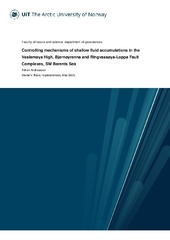| dc.description.abstract | The southwest Barents Sea is a large sub-province within the Greater Barent Sea, an extensive epicontinental shelf that stretches from the northern coast of Norway, northward to Svalbard, and eastward to Franz Josef Land in Russia. This region has undergone a complex geological evolution, with phases of tectonic activity during the Paleozoic to Early Cenozoic. In the late Cenozoic, it was through several glacial cycles.
This study utilizes 3D seismic data (WG1003) to investigate potential fluid flow systems associated with both tectonic and glacial activity in mainly the Veslemøya High, Bjørnøyrenna Fault Complex (BFC), and Ringvassøya-Loppa Fault Complex (RLFC). Events of compression and extension, related to orogenies and continental break-up, have led to extensive and complex fault systems. These tectonic processes may have contributed to the development of deep-rooted faults that might serve as migrational pathways for fluids of thermogenic origin. Glacial activity during the Late Cenozoic has significantly influenced the region's subsurface properties. Many cycles of ice loading, unloading, uplift, erosion, and variable sedimentation rates have contributed to potential overpressure regimes, fault reactivation, and fluid migration. Two groups of high amplitude anomalies (HAAs), with sub-adjacent acoustic masking zones, in Cenozoic stratigraphy have been analyzed to further understand their origin, distribution, relationship to underlying features, and glacially induced processes. In addition, the seismic expression of a potential tilted bottom simulating reflector has been analyzed to understand its origin, relationship to subsurface fluid flow, and glaciations.
The findings of this study support the interpretation that fluid flow systems in the southwestern Barents Sea are controlled by an interplay between tectonic structures and glacial activity. It offers insight into the occurrence and spatial distribution of possible shallow gas anomalies and controlling mechanisms. | |


 English
English norsk
norsk
